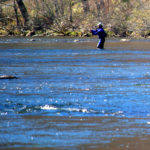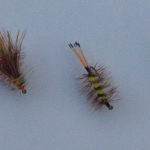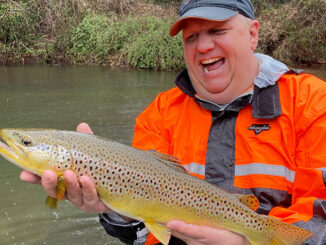
Best fly-fishing of year often arrives this month
May is an ideal time to be on a mountain trout stream. Wildflowers are in bloom, dogwoods and rhododendron are flowering and a multitude of mayfly, caddis and stonefly hatches are coming off — more hatches than any other time of the season.
“May is the best fly fishing month of the year,” said Kevin Howell, owner of Davidson River Outfitters in Brevard. “Best time to fish is from mid-day until dark. That’s when you’ll see the most hatches and the best activity.”
Howell recommends using Nos. 16-14 Yellow Sally, Nos. 12-10 Jim Charley, Nos. 14-10 Red Fox Squirrel, Nos. 12-10 Sheep Fly, Nos. 14-12 Yellow Palmer and a No. 14 Foam Stone, all tied on a 4X or 5X tippet.
Howell likes to get to a stream around 6 or 6:30 p.m., stake out a good pool, and pick off rising trout.
Marc Hipp of Brookings’ Anglers in Cashiers agrees that May is the best fly-fishing month because of the abundant hatches. Fishing conditions, however, may be different than at other times of the year.
“Fish change their holding patterns in late spring, moving from deep water and pools to swifter water such as runs and ripples,” he said.
Hipp’s fly choices are Little Yellow Stone, Yellow Sally, Yellow Stimulator, all in Nos. 16-14, Nos. 16-12 Light Cahill, Nos. 14-12 March Brown (for late March and early May) and Nos. 16-12 Brown Stone in the latter part of the day. Nymph choices are Nos. 16-10 Golden Stone, Nos. 16-8 Tellico with a yellow body, Nos. 14-10 Stickbait, Nos. 18-12 Pheasant Tail, Nos. 16-12 Zug Bug, Nos. 18-10 Prince (good year-round) and a No. 12 red Copper John.
Although Hipp agrees that the best activity is usually late in the day, early-day fishing also can be productive.
“You can start with nymphs and switch to dry flies,” said Hipp, who uses a tandem-rig for early-day fishing, tying a soft-hackle fly such as a Pheasant Tail as a dropper with a larger dry fly on top.
“This combination works very well in early spring,” he said.
For high, swift water, he recommends a streamer such as Nos. 10-6 olive or white Sculpzilla or similar pattern.
“You can dead-drift it, swing it through runs or strip it,” he said, “and it covers a lot of water.”
Miller Watson of Hookers Fly Shop in Sylva said delayed-harvest waters are especially productive in May, and all delayed-harvest streams are stocked the last week in April or the first week in May. The 5.5-mile delayed-harvest section of the Tuckasegee River will get 8,500 rainbow, brook and brown trout — the last stocking scheduled until October. Other delayed-harvest streams will get additional stockings in June and a few in July.
Watson recommends Nos. 16-14 Parachute Adams with either a white or pink parachute, No. 8 Hot Head Stone Fly, Nos. 16-14 Hare’s Ear, Nos. 16-14 rubber-legged Paramadam and Nos. 8-6 olive or black Woolly Booger. Best technique for using big nymphs, he said, is to cast upstream and strip the fly back toward you.
Charlie Downs of Curtis Wright Outfitters in Asheville and Weaverville said presentation is much more important than fly-selection.
Mountain trout are opportunistic feeders, he said. “They don’t have a lot of food sources,” especially in the high-gradient, wild-trout streams. “If a fly looks like a bug, floats like a bug and is the right size, a trout will try to eat it,” he said.
Keeping a low profile is very important, he said, because wild trout are easily spooked.
“Stay out of the water as much as possible,” he said. “A wild trout will pick up vibrations even if you walk on the bank close to the water.”
Downs uses an 8 ½- or 9-foot rod even on small streams.
“A long rod gives me better control, and I get a better drift,” said Downs, whose leaders are usually nine feet with a 5X tippet. His choices of flies include Parachute Adams, Yellow Palmer, Yellow Stone and bushy patterns that float high even in swift water.
Recommended streams for spring fishing include the Davidson River, East Fork of the French Broad, South Mills River, Bradley Fork (a tributary of the South Mills), South Toe River, Newberry Creek (a tributary of Curtis Creek in McDowell County), Mineral Creek in Buncombe Count and Bradley Fork, Deep Creek and Cataloochee Creek in the Great Smoky Mountains National Park.
For delayed-harvest fishing, both the Tuckasegee River and Nantahala River have the most trout per mile. With the exception of a few high-elevation streams in the Great Smoky Mountains National Park, most survived the winter in good condition. Water levels are good, thanks to frequent winter and spring rains, so fishing conditions should be excellent. The best advice from all the guides contacted is to get out on a stream and experiment. Find a combination that catches trout and stick with it.







Be the first to comment